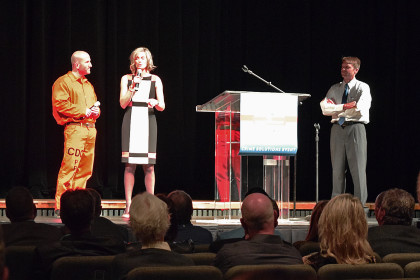Shuttering the Redding Library, cutting back on non-essential services and eliminating some city positions are three ways to fund the wide-ranging package of solutions to Redding’s crime problems that were unveiled Thursday during a well-attended presentation by the volunteer Safe City Project.
“Whatever it takes” to make the city safe, said April LaFrance, a Redding business owner who spearheaded the 3-month-long project. Coming up with the money will be tough, she conceded, but failing to act would be akin to trying to secure a home missing its front door.

Perry, a Sugar Pine Camp inmate firefighter, April LaFrance and Cory McCandliss. Photo by Jon Lewis.
An audience estimated at 1,000 partially filled the Civic Auditorium to listen to LaFrance and members of the project, including a “shark tank” of advisors, identify 11 areas of concern and present the corresponding solutions that were developed during some 1,077 hours of volunteered time.
“Most of us have gathered out of frustration with crime,” LaFrance said, “and we’re here because we believe Redding is valuable.” The Safe City Project, which did not involve any city employees, was endorsed by the City Council in August. “We have nothing to gain, other than a better city,” she said.
Project members toured the Shasta County Jail, went on ride-alongs with Redding police officers, visited homeless encampments, talked to community leaders and researched crime-prevention programs in other cities.
 They identified four focus areas: lack of jail space; residential and commercial property crimes; homeless encampments; and drug and alcohol addiction connected to crime.
They identified four focus areas: lack of jail space; residential and commercial property crimes; homeless encampments; and drug and alcohol addiction connected to crime.
Different project members then presented 11 specific problems and matched them with proposed solutions. They were, in order:
1. Establish a reserve police force of retired officers with the qualification and training to back up Redding’s understaffed corps of officers. The reserve force would allow Redding police to stay on the street where they can take a more proactive approach to crime prevention, according to present Chad Russell.
2. Create neighborhood groups similar to Jason Schroeder’s Stand Up Redding. “We’re not a small town, but we can feel that way again,” Schroeder said to a round of applause. “We need to make sure our neighborhoods are safe.
3. Beef up Redding’s code enforcement program and use a sliding scale of fines to force owners of rundown hotels and vacant homes to bring their properties up to code.
4. Establish a “sobering center” as an alternative to jail for publicly intoxicated people. A social services organization would open the center with $250,000 in seed money from the city, according to a presenter who identified himself as Christian.
Such a center would free up jail beds, steer inebriants toward rehabilitation, allow police to spend more time on the streets “and take back the spaces we love,” Christian said.
5. Establish a community court to hear petty crime cases. This court would emphasize community service and work release programs to match illegal actions with consequences. “We need something to convince them to stop (committing crimes) or leave,” presenter Patrick McNally said.
6. Renovate the Shasta County Jail annex on Breslauer Lane to make room for 65 to 80 inmates awaiting trial. Renovations would cost $1.3 million and the annex would cost $2 million a year to staff, according to a presenter identified only as Joe.
7. Establish a work camp for Shasta County inmates, similar to the California Department of Corrections’ Sugar Pine Camp that houses Cal Fire inmate crews. In one of the night’s highlights, Perry, a Sugar Pine inmate, told how working at the camp gave him a sense of self-worth and the motivation to complete a college degree.
Cory McCandliss, general manager of the Civic Auditorium, said a community member has offered to donate 40 acres of land for the work camp. “All we need is the funding,” he said, noting a camp would be half the cost of a conventional prison.
8. Expand the drug and alcohol rehab and mental health counseling services offered by Visions of the Cross, Northern Valley Catholic Social Service, the Good News Rescue Mission and other organizations.
9. Make it easier to report illegal homeless encampments and help persuade absent property owners to clear their land of camps that degrade Redding’s natural resources and threaten its growing tourism business.
10. Support the Homeward Bound program that provides eligible runaways and other transients with one-way bus tickets and meal vouchers so they can reunite with family members. The Good News Rescue Mission has agreed to operate the program.
11. Create a coalition of faith-based organizations to provide more cohesive and coordinated services to Redding’s neediest residents. “Let’s harness the strength of the faith-based community,” said Nate Edwardson, the lead pastor at The Stirring in Redding.
Incoming Councilwoman Kristen Schreder said she was impressed with the time and effort expended by members of the Safe City Project. “The key is identifying the problem and what the solution is. It really helps to find a way that’s focused on solutions.”
LaFrance said there was sure to be a considerable amount of discussion of the project’s recommendations in the following weeks and she encouraged people to engage with the project by visiting www.SafeCityProject.org.
Jon Lewis is a freelance writer living in Redding. He has more than 30 years experience writing for newspapers and magazines. Contact him at jonpaullewis@gmail.com.


